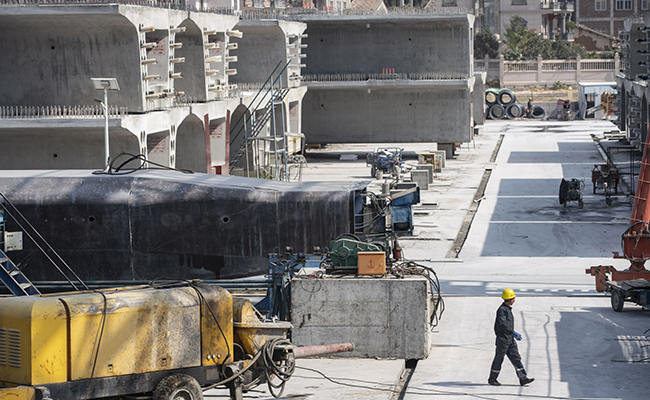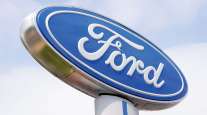Bloomberg News
Biden Starts Infrastructure Bet With US Far Behind China

[Stay on top of transportation news: Get TTNews in your inbox.]
President Joe Biden is betting that a multitrillion-dollar economic plan centered around infrastructure spending will do more than bolster an American economy hammered by the coronavirus pandemic: It will ensure his country’s competitiveness against China for decades to come.
“If we don’t get moving, they’re going to eat our lunch,” Biden told lawmakers in a pitch for his proposal shortly after his call last month with Chinese President Xi Jinping. “We just have to step up.”
Biden’s advisers will present him this week with a detailed proposal for a plan whose cost could touch $3 trillion, according to three people familiar with the deliberations. Infrastructure and climate change have long been described as key efforts in the pending program, and the new details show the administration is eyeing some $400 billion in so-called green spending, according to one of the people.
Even if he gets all he asks for, catching up to China on infrastructure won’t be easy.
While U.S. officials have been promising an approaching “infrastructure week” since the early days of the Trump administration, China has been plowing ahead for years. In February, Xi’s government set out a 15-year plan for the country’s transportation network. It pledges to extend China’s rail network from 146,300 kilometers (91,000 miles) in 2020 to about 200,000 kilometers (124,000 miles) by 2035 — enough to circle the equator more than five times.
The plan also calls for adding 162 new civilian airports, after Beijing’s new $11 billion international airport opened last year.
In contrast, the U.S. has built just one major airport — Denver International — since the mid-1990s. And on rail, even a bipartisan effort to build the long-sought “Gateway” rail tunnel between New York and New Jersey — part of the busiest rail line in the U.S. — has foundered in recent years.
China’s infrastructure efforts aren’t limited to China. Since Xi introducing the so-called Belt and Road initiative in 2013, the World Bank estimated China has built or pledged to construct $575 billion in energy plants, railways, roads, ports and other projects across the globe from Sri Lanka to Greece. Morgan Stanley in 2018 said total spending on the effort could reach $1.3 trillion by 2027.

The construction site for the Meizhou Bay cross-sea bridge, a part of the Fuzhou-Xiamen high-speed railway project, in Putian, Fujian province, China. (Qilai Shen/Bloomberg News)
Biden is hoping to begin leveling the playing field. If he can win support for his plan in a deeply divided Congress, there’s certainly no shortage of projects to work on.
The U.S. got an early start on all its infrastructure, but much of it is now aging or decrepit. According to the American Society of Civil Engineers 2021 Infrastructure Report Card, 43% of U.S. public roadways are in poor or mediocre condition, and 42% of the nation’s 617,000 bridges are at least 50 years old. About 7.5% of them are considered structurally deficient.
“The United States is entering what could be a decadeslong competition in which economic and technological power will matter just as much, if not more, than military might,” Jonathan Hillman, a senior fellow at the Center for Strategic and International Studies, wrote last month. “Starting this race with decaying infrastructure is like lining up for a marathon with a broken ankle.”
The engineering report doesn’t go into another challenge that may have a defining imprint on competitiveness between the U.S. and China: technology infrastructure.
The U.S. is still mired in domestic political debates about how to get broadband technology rolled out across the nation. More than a third of Americans in rural areas still lack high-speed access, according to the Federal Communications Commission. Money to help close that gap is expected to be part of any new U.S. proposal.
Basic materials stocks are among those likely to benefit from increased spending on infrastructure projects such as roads and bridges, traditional favorites of lawmakers.
“Activity in the U.S. cement industry is poised to surge through 2021, with a potential government infrastructure package expected to spur an acceleration” in second-half demand, Bloomberg Industries analyst Sonia Baldeira wrote in a March 16 note.
Cemex SAB’s American depositary receipts surged 29% this year through March 22, about six times the gain in the Standard & Poor’s 500 Index. Construction supplier Eagle Materials Inc. leaped 26%, while aggregates producer Martin Marietta Materials Inc. jumped 13%.
Despite Biden’s impulse to push for big spending, the track record of recent presidents suggest he’s likely to fall short.
President Donald Trump, a real estate developer who was touted as a potential “builder president” upon his arrival in Washington, proposed a $1 trillion infrastructure plan — funded mostly by private investment — that never won approval.
President Barack Obama vowed to bet big on high-speed rail as a tool to help the U.S. emerge from the 2008 financial crisis. He spoke frequently in his first term about developing a rail network that could grow to rival the interstate highway system and included $8 billion in his 2009 economic stimulus package for high-speed rail lines. But Republican governors in states like Ohio, Wisconsin and Florida rejected the money, and a decade later a line in California that most of the rejected money was funneled to is still only in its early stages.
“Shovel-ready was not as shovel-ready as we expected,” Obama said in 2011 when reflecting on his struggles to harness infrastructure projects to jump-start the economy.
Biden could face similar hurdles and it’s not a given that the new president will get his plan approved. He is expected to make his case for his so-called Build Back Better program in a joint address to Congress in April. Democratic aides have increasingly expected the program will be split into more than one package, given legislative challenges.
Meanwhile, China has had access to cheaper labor, engineering prowess and experience in massive infrastructure projects, both at home and abroad. It also had the benefit of building much of its infrastructure from scratch over the past few decades as its economy boomed, with little fiscal scrutiny and fewer protections for workers, the environment or property rights.
The government has long relied on big infrastructure spending to boost the domestic economy and, more recently, to generate international support through investing or providing aid overseas.
That spending helped insulate China’s economy from the effects of the 2008 global financial crisis, and again limited the decline in growth after the coronavirus pandemic hit last year. However, the reliance on building roads, railways and airports to support growth also cause a spike in debt, with some of that money funneled into unnecessary infrastructure and uneconomic boondoggle developments.
The World Bank estimated in 2019 that only one-sixth of China’s high-speed rail lines made enough money to cover their operating costs and service the construction debts. That problem is likely to increase with the plan to build even more, as the newer lines will be mostly in poorer and less densely populated parts of the country where there’s less demand.
Xi also faces a set of financial and demographic challenges that his government will struggle to address as the population ages and the country’s previous “one child” policy means there aren’t as many workers to replace retirees.
“In the coming years, the country will be traveling a demographic downslope with an increasingly heavy debt burden and tough prospects for improving the productivity of its workers,” said Ryan Hass, a former China director on the U.S. National Security Council and author of “Stronger: Adapting America’s China Strategy in an Age of Competitive Interdependence.”
That may help give Biden an opening to fend off Beijing’s bid to dominate the 21st century.
“If the United States makes progress in fixing some of its own problems, including its infrastructure deficit, it will remain highly competitive against any challenger, including China,” Hass said.
Want more news? Listen to today's daily briefing below or go here for more info:
— With assistance from James Mayger and Saleha Mohsin.




